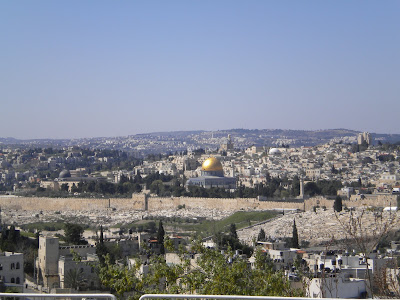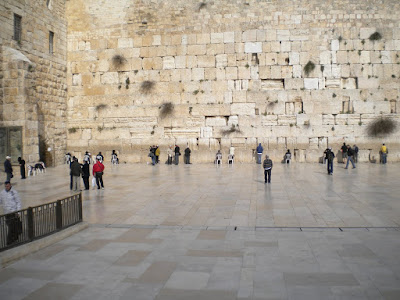
Last evening at sunset Max and I visited the newly dedicated Hurva Synagogue (beit ha-Knesset ha-Hurba, which literally means "the Ruin Synagogue"). This synagogue is very ancient, having been founded in the 2nd century A.D. It has been destroyed many times since, including in 1721 after which it lay in ruins for about 150 years. This is when it became known as the Hurva or the "Ruin" Synagogue. It was rebuilt in 1864, but was again reduced to rubble by the Jordanian-controlled Arab Legion during the 1948 Arab-Israeli war of Independence. After the site came under the control of Israel in 1967, plans were laid to rebuild it according to its 1864 plan, but it took 40 years to do so. It was dedicated a few hours after I arrived in Jerusalem this week!
Visiting the Hurva Synagogue at the commencement of Shabbat on the week of its dedication was one of the most amazing experiences of my life. We first went into the basement where the men were at prayers. We entered the room and moved to the back. The room was laid out in two long aisles before very ancient pillars. Before the men were slanting desks where the prayer texts could be laid out. These were readily available in bookshelves along the walls. A cantor would sing the lines, and then at intervals all of the men would sing, reading from the books. Most of the men were wearing long black coats and black broad brimmed hats. There were many small boys, wearing Kippahs. (Max and I wore the blue Kippahs I bought from Shaaban Amer).
After observing for fifteen or twenty minutes in this basement part of the Hurva, we moved outside and around the building to the main entrance. In a mighty crush of men, we moved into the main room of the Synagogue upstairs, beneath a soaring dome decorated with murals of Rachel’s Tomb, the Tomb of the Patriarchs, the Tower of David and the Western Wall. In the center of the room under a canopy with four pillars was a raised platform where the cantor stood wearing a Tallit, a long white and striped prayer shawl, with a few old grizzled men around him. The voice of the cantor was amazing—he really sounded like Pavorotti to me. The room was filled to overflowing with perhaps three to four hundred men and boys, who were sitting at the long desks or standing shoulder to shoulder in the aisles and along every wall. It was a great crush of humanity. We all faced the Western Wall, which was only a few hundred meters away. (By the way, that reminds me of something our young guide said on the tour of the Western Wall Tunnels—he said that all Jews, wherever they might be in the world, pray towards the Holy Land. Those who live in the Holy Land pray towards Jerusalem. Those who live in the Jerusalem pray towards the Temple Mount. Those near the Temple Mount pray toward the Foundation Stone on the top of the Temple Mount.)
The variety of the male worshipers was amazing. Men with simple Kippahs on their heads and collared white shirts. Most men had on black jackets. Some wore the wide brimmed black hats. Others had on splendid fur hats with cylinder-like rims. Most austentacious were the men with the fur hats and long black and white pin-striped jackets with wide silk sashes at the waist. The men swayed back and forth as they sang, or bobbed their heads over their open prayer books. Their devotion and utter joy was almost palpable. Someone handed us a prayerbook and Max followed along in the Hebrew. There were small niche-like windows above man-height on the right side opening onto what was obviously an elevated plaza outside, and through these tiny windows we could see scores and scores of girls and women, all dressed finely with scarves, looking through joyfully at their fathers or lovers. It was a truly amazing sight. The devotion, the joy, the unbridled worship was enlightening. I was also struck by the order, the uniformity and by the symmetrical beauty of the worship--especially since modern Judaism essentially has no monolithic leadership, no central authority figure. Each man knew his place, and the proper way to proceed, born of centuries--no millenia--of custom and practice! This was a special, special occasion to be in this unique and sacred place—on the first Sabbath at sunset after the dedication of this edifice.
Incidentally, it was the dedication of this structure which resulted in Hamas issuing a proclamation of a “Day of Rage” on Tuesday, which shut down so much of the city. Max said that the Palestinian fear is that now that the great synagogue is completed, the next step will be a Jewish move to reoccupy the Temple Mount and build the Temple.
After spending perhaps a half an hour inside the great Synagogue, Max and I went to the Western Wall, which was a scene of utter joy in the twilight. Hundreds and hundreds of worshippers gathered, all in their Sabbath best, pressing toward the Western Wall. Max and I stood at the wall, wearing our blue Kippahs, and with hands outstretched to the Herodian stones, said our private devotions. Max and I spent perhaps an hour at the Western Wall. We also went inside the tunnels to the side fo the wall, where the exposed Herodian Stones of the Temple Mount run for many hundreds of feet beneath the living buildings of the city above. Here there were hundreds and hundreds of additional worshippers. There were many elaborate Torah cabinets with velvet covers, where various cantors sang with scores of men surrounding them. There were great libraries of books on the back shelves and in alcoves. At one point I heard exhuberant singing and the drum-like beat of hands upon wood, and wondered if some enthusiastic teenagers were singing, but it was an old Cantor, who with his head bobbing tremendously, was singing while banging his hands on the wooden rostrum, and both old men and young boys surrounding him were singing in a haunting tone a song of pure joy. Back out on the plaza before the Wall there were great rings of men, perhaps 50 to 75, dancing in great circles. In one ring I saw perhaps 20 Israeli soldiers, dressed in their battle gear with automatic rifles slung over their shoulders and extra ammunition clips in their belts, linked arm in arm in the great dancing circle with men and teenagers in their hats or Kippahs. It was an unforgettable sight on this unforgettable night.



























































